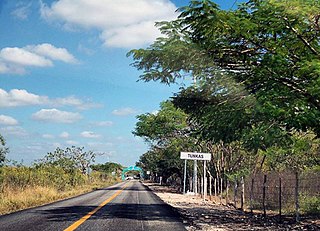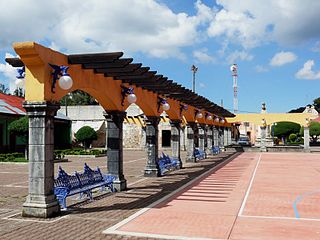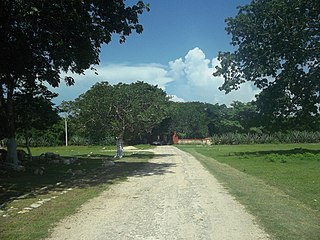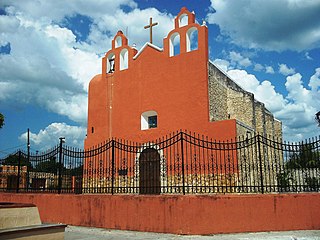
Tunkás Municipality is a municipality in the Mexican state of Yucatán containing 514.79 square kilometres (198.76 sq mi) of land and located roughly 98 kilometres (61 mi) east of the city of Mérida.

Halachó Municipality is a municipality in the Mexican state of Yucatán containing (671.91 km2) of land and located roughly 68 km southwest of the city of Mérida.

Tixkokob Municipality is a municipality in the Mexican state of Yucatán. Its municipal seat is located in the City of Tixkokob. The town of Tixkokob is famous within the area for high quality hammock weaving. The municipality made up largely of working class communities.

Omitlán de Juárez is a town and one of the 84 municipalities of Hidalgo, in central-eastern Mexico. The municipality covers an area of 110.5 km².
Tekom Municipality is a municipality in the Mexican state of Yucatán. Tekom is also the name of the municipality's largest settlement and seat of the municipal government. In the XII national census conducted by INEGI in 2000, Tekom municipality recorded a population of 2,660 inhabitants. In the intermediate census count undertaken by INEGI in 2005, the total municipal population was recorded as 2,933 inhabitants, 2,413 of whom spoke one of the recognised indigenous languages of Mexico.

Chemax Municipality is a municipality in the Mexican state of Yucatán containing 1,098.6 km2 of land and located roughly 185 km east of the city of Mérida.

Homún Municipality is a municipality in the Mexican state of Yucatán containing (192.89 km2) of land and located roughly 50 km southeast of the city of Mérida.
Hacienda Kancabchén is located in the Homún Municipality in the state of Yucatán in southeastern Mexico. It is one of the properties that arose during the nineteenth century henequen boom. There are numerous other properties of this name in the Yucatán including Hacienda Kancabchén in Baca, Hacienda Kancabchén (Halachó), Hacienda Kancabchén (Motul), Hacienda Kankabchén (Seyé), Hacienda Kankabchén (Tixkokob), Hacienda Kancabchén (Tunkás), Hacienda Kancabchén Ucí and Hacienda Kancabchén de Valencia.

Motul Municipality is a municipality in the Mexican state of Yucatán. It contains 297.63 km2 (114.92 sq mi) of land and is roughly 45 km (28 mi) east of the city of Mérida.

Hacienda Kancabchén Ucí is located in the Motul Municipality in the state of Yucatán in southeastern Mexico. It is one of the properties that arose during the nineteenth century henequen boom. There are numerous other properties of this name in the Yucatán including Hacienda Kancabchén in Baca, Hacienda Kancabchén (Halachó), Hacienda Kancabchén (Homún), Hacienda Kancabchén (Motul), Hacienda Kankabchén (Seyé), Hacienda Kankabchén (Tixkokob), Hacienda Kancabchén (Tunkás) and Hacienda Kancabchén de Valencia.

Timucuy Municipality is a municipality in the Mexican state of Yucatán containing (63.15 km2) of land and located roughly 25 km southeast of the city of Mérida.

Muxupip Municipality is a municipality in the Mexican state of Yucatán containing 54.93 square kilometres (21.21 sq mi) of land and located roughly 30 kilometres (19 mi) northeast of the city of Mérida. It is bounded on the north by Motul town, on the south by Cacalchén Municipality and on the east and the west by Yaxkukul Municipality and Tixkokob Municipality.

Chikindzonot Municipality is a municipality in the Mexican state of Yucatán containing (352.56 km2) of land and located roughly 170 km southeast of the city of Mérida.

Cantamayec is a municipality in the Mexican state of Yucatán containing (502.02 km2) of land and located roughly 110 km southeast of the city of Mérida.

Buctzotz Municipality is a municipality in the Mexican state of Yucatán containing (543.45 km2) of land and is located roughly 95 kilometres (59 mi) northeast of the city of Mérida. It contains several churches and a hospital, Centre de Salud Buctzotz, in the eastern part of the main town.

Calotmul Municipality is a municipality in the Mexican state of Yucatán containing (361.50 km2) of land and is located roughly 185 kilometres (115 mi) east of the city of Mérida.

Cenotillo Municipality is a municipality in the Mexican state of Yucatán containing (614.43 km2) of land and is located roughly 115 kilometres (71 mi) east of the city of Mérida.

Río Lagartos Municipality is a municipality in the Mexican state of Yucatán containing (249.09 km2) of land and is located roughly 215 kilometres (134 mi) northeast of the city of Mérida.

Sucilá Municipality is a municipality in the Mexican state of Yucatán containing 256.76 km2 of land and is located roughly 150 kilometres (93 mi) northeast of the city of Mérida.

Tinúm Municipality is a municipality in the Mexican state of Yucatán containing of land and is located roughly 140 kilometres (87 mi) east of the city of Mérida.




























